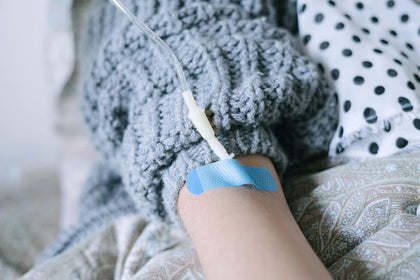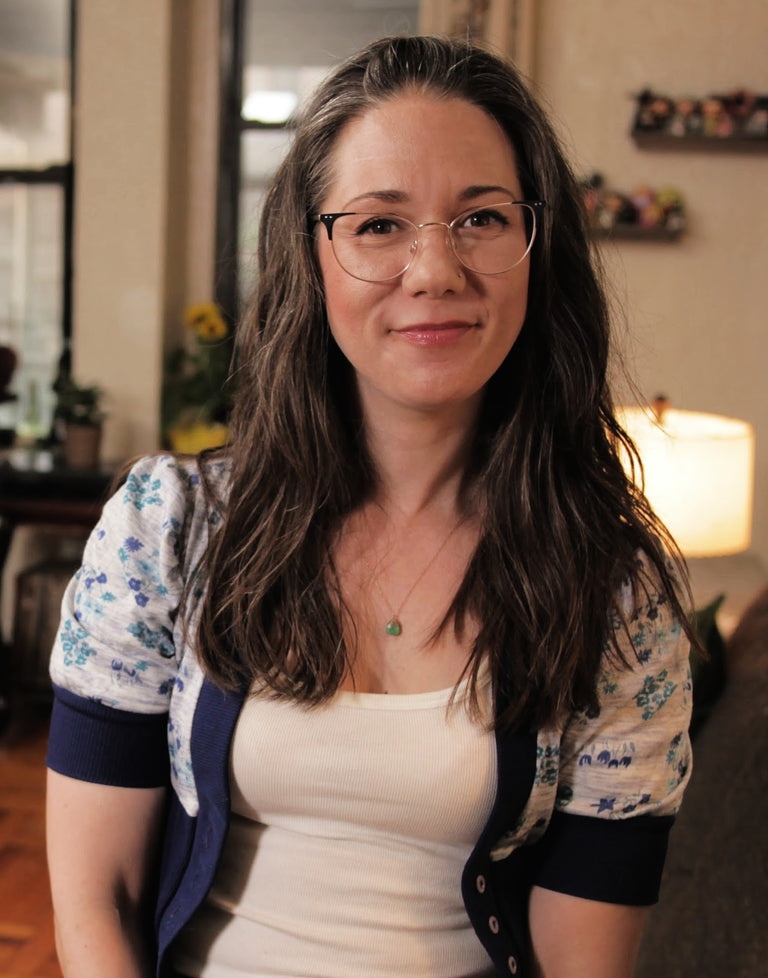Hair loss caused by chemotherapy is one of the most dreaded and distressing side effects of cancer treatment. But it can help to understand why hair falls out and what to expect. Read on to get the full picture, including how you can support your scalp during and after chemo and what hair wellness options are available to support your hair journey.
What Is Chemotherapy?
Chemotherapy is a drug treatment protocol used to treat a wide variety of cancers, along with other conditions like bone marrow diseases and immune system disorders. A wide variety of different chemotherapy drugs can be used alone or in combination and at varying dosages. These drugs are administered as pills, chemotherapy infusions (intravenous), shots and creams.
Why Does Chemotherapy Cause Hair Loss?
Cancer cells divide rapidly, and these drugs work by targeting these rapidly dividing cells. “Cancer proliferates rapidly because of the rate of which abnormal cells divide, and chemotherapy drugs stop this from happening,” explained Dr. Tina Gupta with Women’s Health and Aesthetics.
But not all rapidly dividing cells in the body are cancerous. The normal cells in the lining of the mouth and the stomach contain rapidly dividing cells. So do our follicles. “Rapid cell division normally occurs in the hair follicles, which makes them vulnerable to the powerful chemotherapy drugs,” added Dr. Daniel Boyer, medical doctor and researcher with the Farr Institute.
The chemotherapy drugs cannot differentiate between healthy cells and cancerous cells, so chemotherapy can cause hair loss by inadvertently impacting hair follicles.
What Kind Of Hair Loss Does Chemo Cause?
At any given time, most of the hair follicles on our head and body are in an active phase of growth, called the anagen stage. Chemotherapy disrupts this active growth stage, causing the follicles to shut down and stop producing the cells that make up our strands of hair. This particular form of hair loss is called anagen effluvium.
While losing the hair on your head is common, you might also notice the loss of other body hair. “Loss of eyebrows and eyelashes, as well as axillary (underarm) and pubic hair is possible too,” said Dr. Daniel Vorobiof, oncologist and chief medical director of Belong Life.
You might also see varying degrees of hair loss. “Total alopecia is common, but it can also be scattered or patchy,” added Dr. Vorobiof.
Learn More: Anagen Effluvium Explained
Does Chemo Always Cause Hair Loss?
Hair loss caused by chemotherapy depends on a variety of factors, and not every person will lose their hair during chemotherapy treatment. Studies suggest that about 65% of people who receive chemotherapy will experience hair loss.
“The timing and extent of alopecia depend on the type of chemotherapy drug, its dose and schedule,” explained Dr. Vorobiof. “Risk also differs substantially between chemotherapy drugs, with a number of them causing little to no alopecia."
The type, combination, frequency and dose of chemotherapy are part of it, and so is your own body and physiology.
Although some chemotherapy treatments are given weekly in small doses, others are given less frequently but in higher doses and may be more likely to cause hair loss. “Higher doses of the biggest hair growth offenders will have a more dramatic impact on your hair follicles,” said Dr. Cynthia Bailey, board-certified dermatologist and founder of Dr. Bailey Skin Care. Intravenous administration is also more likely to impact follicles, as is receiving a combination of different chemotherapy drugs.
In addition, other medical conditions, your general health and nutrition and the impacts of stress could influence hair loss. As a result, two people undergoing the same treatment protocol may have very different experiences.
Talk to your doctor to understand the medications that will be used in your chemotherapy protocol and how likely they are to cause hair loss.
See: Every Cause of Hair Loss Explained
When Does Hair Loss From Chemo Begin?
When hair loss begins also varies from person to person, but hair shedding can come on quickly.
“Due to the fact that chemo is directly disrupting the active growth phase of the shafts, hair can start to shed immediately,” explained Dr. Erum Ilyas, board-certified dermatologist and founder of AmberNoon. “Most often, we see it occur within a few days to weeks of [the] onset of chemo, followed by potentially complete loss two to three months into treatment.”
Commonly, people start to notice hair loss within a few weeks of beginning therapy. It might start off slowly and become more drastic as you continue your cancer treatments. You might experience a gradual thinning, or you could see hair begin to fall out in clumps.
As with many forms of hair shedding and loss, you will probably start to notice loose hairs on your pillowcase, in a brush or comb and in your sink or shower drain. You might also notice tenderness, itchiness or discomfort on your scalp. “Many patients note a sensation of discomfort when this happens—I certainly did when I received chemotherapy to treat breast cancer seven years ago,” said Dr. Bailey.
Read: What Causes Chemo Curls?
How Long Does Hair Loss From Chemo Last?
Like the onset of hair loss and its severity, how long the hair loss lasts also varies.
Hair regrowth usually begins within weeks of ending chemotherapy, though some might see hair regrowth start before they complete treatment. “Typically, the hair follicle restarts its normal cycling within a few weeks after the cancer treatment ends, and visible regrowth becomes apparent within three to six months,” said Dr. Vorobiof.
Often hair initially comes back with a soft and fine fuzz-like texture that becomes thicker and more coarse over time. You might also see changes in the color, texture and type of hair that grows back after chemotherapy.
“We see in our patients that the new hair frequently has different characteristics, with changes in natural hair color and form (gray, curly, straight) likely due to differential effects of chemotherapy on the hair follicle pigment cells and inner root cells,” explained Dr. Vorobiof. “Generally, these effects resolve over time.”
Hair grows about a half-inch per month, meaning it can take about a year after you start to see new growth to gain about 6 inches of new hair. It takes time, patience and a holistic approach to hair care to regrow hair after chemotherapy.
And while timelines for regrowth vary, perhaps the best news is that for most hair growth completely returns to normal. In one study of people with breast cancer treated with chemotherapy, only 4% still had hair loss after two years. That said, it’s important to note that some types of chemotherapy (such as busulfan and cyclophosphamide) have a higher risk of permanent hair loss.
Is There a Way to Prevent or Minimize Hair Loss?
While there is no way to completely prevent hair loss due to chemotherapy, one tool is becoming more widely used to help minimize hair loss by insulating follicles from the impact of the drugs.
“Scalp cooling (also called ‘cold caps’) is a preventative method that can reduce the risk of hair loss caused by chemotherapy, protecting the hair follicles from the circulating cancer treatment,” explained Dr. Vorobiof.
It can be done with ice packs, scalp cooling caps or other cooling systems designed to make the follicles constrict, cutting off the blood supply that brings the chemotherapy drugs to the follicles.
Research is being done to better understand how scalp cooling helps prevent hair loss due to chemotherapy, though there are already FDA-approved devices available.
“Patients considering scalp cooling should be informed that success rates vary,” said Dr. Vorobiof. “In addition, there are cost implications as well as some other side effects, such as cold intolerance, headaches and lightheadedness. It’s also important to note that patients may be required to spend a prolonged time in the clinic for fitting and cooling before the chemotherapy is administered."
Current evidence suggests that scalp cooling is most effective for taxane-based chemotherapy regimens compared with anthracycline-based chemotherapy regimens.
Holistic Support for Hair Health
There are many tools available in a toolkit for holistic hair health, like a healthy and balanced diet, exercise, getting enough sleep and proactively managing stress levels. But while dealing with a cancer diagnosis and undergoing chemotherapy, many of these tools might be out of reach. Know that doing whatever you can to get through this is just what you can and should be doing.
Here are a few tools and tips to consider making use of.
Seek Out Support
“The first step to dealing with the emotional impact of hair loss during cancer treatment is to just recognize and name the feelings that are coming up around it,” said Alexia Holovatyk, Ph.D. and licensed psychologist with Thrive Psychology. “There is no wrong answer. Any emotion you are feeling— whether it is grief, sadness, anxiety, gratitude or numbness — is valid."
According to the American Cancer Society, managing the psychological impacts of cancer treatment is an essential part of your cancer treatment plan. Share your struggles with family, friends and loved ones. Seeking out support in community settings like group therapy or cancer patient support groups can often be a very valuable tool. Speaking with others who are facing similar challenges can be not only comforting but also provide you with ideas and advice on coping with the changes to their appearance. And of course, licensed counselors or psychologists can provide valuable additional support.
Be Gentle
Pamper your follicles by getting in the habit of being very gentle on your hair during and after chemotherapy. Avoid excessive pulling or tugging from brushing, combing or tight hairstyles. Avoid heat styling and chemical treatments, and wash only when necessary. Seek out all-natural non-irritating shampoos, conditioners and other hair care products that are designed to support hair and scalp wellness.
Consider a Head Covering
Not only might wigs, scarves or other hair coverings make you feel more comfortable with your appearance, they might even be covered by your health insurance. Chemotherapy-induced hair loss can make your scalp more sensitive, so coverings can also help protect it from the elements. They can also help regulate your body temperature, as having less hair might make you feel colder.
Be Patient and Kind to Yourself
Receiving a cancer diagnosis and undergoing chemotherapy are perhaps some of the most difficult challenges one faces during their lifetime. Hair loss due to chemotherapy can add more difficulty to an already extremely difficult situation, so for this reason, it’s important to show yourself care, compassion and acceptance before, during and after chemotherapy.
The Takeaway
Chemotherapy causes hair loss by disrupting the hair follicles. The severity of hair loss caused by chemotherapy-induced alopecia varies from person to person and is influenced by the type, frequency, dosage and way the chemotherapy drugs are administered.
Know that for most people, hair returns to normal growth cycles once chemo is stopped. Hair loss is one of the most distressing side effects of chemotherapy, but understanding how and why it happens can help to reduce stress and worry.
Planning ahead to support yourself throughout chemo, with head coverings, gentle hair care products, cancer patient support groups and other tools for stress management are good ways to help yourself through this challenging time.
More From VEGAMOUR
- What Causes Hair Loss in Women?
- How to Tell If Your Hair Is Thinning
- What You Should Know About Radiation & Hair Loss
- What Causes Sudden Hair Loss?
Photo credit: Ivan Samkov/Pexels
Back


















